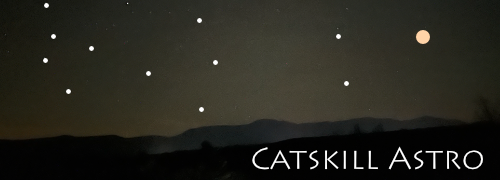Messier Objects
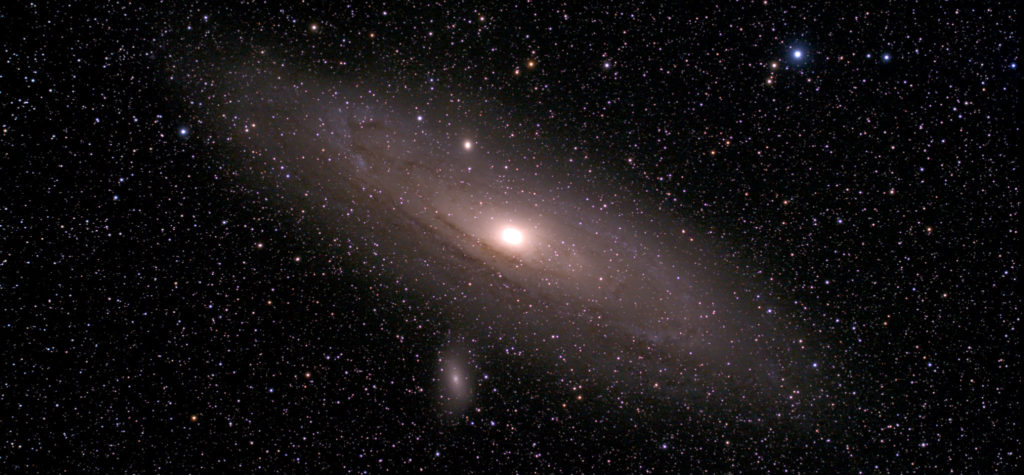
Page 2 of 11
Messier observations 11-20 of 110 total to date.
| Catalog # | Thumbnail | Title/link | Description |
|---|---|---|---|
| M11 | 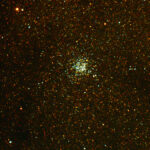 |
M11 / Wild Duck Cluster / NGC 6705 | M11 was discovered by the German astronomer Gottfried Kirch of the Berlin observatory in 1681. It was apparently first resolved into stars by William Derham about 1733. Charles Messier included it in his catalog on May 30, 1764: "Cluster of a great number of small [faint] stars, ....which one can see only in a good instrument; with an ordinary telescope of 3 feet [FL] it resembles a Comet:". <--> This is a dense "open" cluster, located right on top of the Scutum Star Cloud. Frankly it looks more dense than M4, which is categorized as a Globular Cluster. In the 20th century, astronomers would recognize that GC's are some of the oldest stars in the Milky Way, and can be distinguished by low "metalicity" (that bizarre habit of astronomers to describe as a "metal" any element heavier than Helium). GC's were formed from pristine clouds of mostly Hydrogen. OC's had more metals, but this is a distinction that needed a couple of hundred years to establish. In this earlier era, it was driven by the ability of Messier's telescope to resolve individual stars (as here). Whether OC or GC, this is a handsome cluster. I'm showing two captures here: a wide field view using my brand new ASI2600 with the Askar at 600mm; the other from 2024 using the EdgeHD with reducer. |
| M12 | 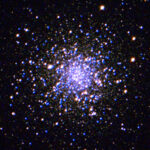 |
M12 / NGC 6218 | M12 was discovered by Messier himself -- #4 so far -- on May 30, 1764: "[T]his nebula doesn't contain any star, it is round & its light faint.... M. Messier has reported it on the second Chart of the Comet observed in 1769." <--> M12 is a "typical" Messier GC, ranking 12th in brightness and 11th in size (out of 29). The brightest part of the core appears highly unsymmetrical, stretching wide at a nearly 45° angle, but if you extend the measurement to include the more moderately endowed regions it's nearly circular at 1070 x 1000 pixels (1.07 ratio). The blue stars convey an almost spiral overlay. This combination of star colors and moderate asymmetry make M12 more distinctive than most Messier GCs, which I find challenging to recognize. In the Catskills, seeing and transparency were poor this evening, making my usual pursuit of tiny Arp Galaxies impossible. Instead I collected M10, M12, and M14. I did, however, add a supplemental observation from March 2025 to the gallery, captured under good, pre-dawn conditions. |
| M13 | 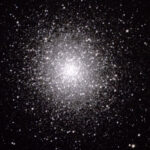 |
M13 / Great Hercules Cluster | M13 was discovered by Edmond Halley in 1714. Halley, later Astronomer Royal, calculated the orbital period of Halley's Comet, named for him posthumously when it appeared on schedule in 1758. It was cataloged by Messier on June 1, 1764: "Nebula without star, discovered in the belt of Hercules; it is round & brilliant, the center [is] more brilliant than the edges, one perceives it with a telescope of one foot [FL]....M. Messier has reported it on the Chart of the Comet of 1779, which was included in the volume of the Academy of that year". <--> M13 is ranked #4 in terms of both diameter and brightness among all Messier GCs. That may be true, but M13 has the densest cluster of stars. It's minimally oblate, by my measurement 1325px wide x 1250px tall (1.06 ratio). If it's "up" when friends visit, or at a star party, it's a "must go to" object, and often the audience's favorite of the night. This entry provides three separate observations of M13. The featured image was captured on a night of unusually excellent seeing and transparency, and provides the best view of cluster itself. Unfortunately, it was so bright, I was unable to recover any star colors. My favorite M13 observation is the wide field view, taken with my Askar V configured at, I think, 600mm, with a view of galaxy NGC 6207, slightly up and to the right. This provides the annotation view in the gallery. In general I think clusters are more interesting in wide-field than close up. Third, I've added an observation from the pre-dawn March 14, 2025 lunar eclipse using my Seestar. This view, with some pretty intense color correction, allowed me to recover more star colors. |
| M14 | 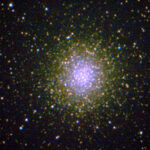 |
M14 / NGC 6402 | This object was discovered by Messier himself (#5 so far) and cataloged on June 1, 1764: "Nebula without star, discovered in the garb which dresses the right arm of Ophiuchus, & situated on the parallel of Zeta of Serpens: this nebula is not large, its light is faint, one can see it nevertheless with an ordinary telescope of three feet and a half [FL]". <--> Ranked 17th in brightness and 14th in size, this is an "average" Messier GC. However, similar to M13, it features a dense, symmetrical, nearly circular core with a ratio I measured of 1.05. Captured toward the end of a long night along with M10 and M12, it looks like conditions, particularly seeing, improved somewhat for this last capture of my evening. I further added a second, wider-field observation from March 2025 captured under better conditions. Brightness falls off fairly dramatically from the center to the edge of the cluster. |
| M15 |  |
M15 / NGC 7078 / Great Pegasus Cluster | M15 was discovered by Jean-Dominique Maraldi in 1746 while observing a comet. Maraldi, who also discovered M2, lived in Paris and was a member of the French Academy. It was recorded by Messier on June 3, 1764: "Nebula without a star... it is round, in the center it is brilliant." Like so many others, the first observer to note individual stars was William Herschel in 1783.<--> M15 is ranked 6th in brightness and 8th in diameter among Messier GC's. It has a distinctive floral character, more like an Aster than a rose: the brightest part of the core represents the disk floret, while the slowly dimming cluster represents the rays. Unlike M5, there does not seem to be a significant halo beyond the globular cluster itself. It is somewhat oblate if you measure only the bright core, with a ratio between 1.1 and 1.2. |
| M16 |  |
M16 / Eagle Nebula / Sh2-49 | This famous target evolved over time. A small, open cluster (NGC 6611) was discovered by Jean-Philippe de Cheseaux in 1745–46. It was cataloged by Messier with a notation of nebulosity, on June 3, 1764 (same as M15-18): "A cluster of small stars, enmeshed in a faint glow, near the tail of Serpens, at little distance to the parallel of Zeta of this constellation; with an inferior telescope this cluster appears like a nebula." Today, these distinction are generally ignored and M16 now refers to the Eagle Nebula complex. <--> M16 includes the famous "Pillars of Creation" of Hubble fame, which emerge in the center and left of the image. The area is surrounded by dark nebulae which are feeding raw materials to the star-incubators in the pillars. This is one of the closest star birthing areas to our solar system. In the gallery you'll also find a later capture (June 1, 2024) taken with the same camera, using my EdgeHD 8" at F10 (full focal length). This was taken with the L-eNhance dual band-pass filter and 40m integration in Bin2. Where I set the histogram in SharpCap for a dramatic, dark look in the initial capture, I went for a much lighter, less saturated view in the second. Both images reward study: it's a fascinating place. |
| M17 | 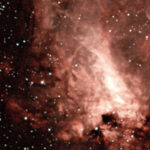 |
M17 / Swan Nebula / Sh2-45 | M17 was discovered by Swiss Astronomer Philippe Loys de Chéseaux in 1745 and cataloged by Messier on June 3, 1764: "A train of light without stars, of 5 or 6 minutes in extent, in the shape of a spindle, & a little like that in Andromeda's belt [M31] but of a very faint light; there are two telescopic stars nearby & placed parallel to the equator. In a good sky one observes this nebula very well in an ordinary telescope of 3.5-foot [FL]." de Cheseaux was a member of the French academy and the discoverer of multiple comets. <--> This object has various nicknames, but I prefer "Swan." The nickname is clear if you view the full-frame shot in the gallery. The white bar is the swan's neck. Its eye is the black spot close to the top edge if you follow the neck up, and a rounded bill is suggested by the nebula extending to the left of the eye. The Swan's body is presented in a foreshortened view, spreading out behind both sides of the head. It is a considerable HII star-birthing region, similar in architecture to the Orion Nebula, but viewed edge-on instead of face-on. The capture is still only 16m, but used the L-eNhance filter which improved contrast and color balance. While I did not keep contemporaneous notes, the star shapes suggest poor seeing. The "related observation" is a widefield view of M16 and M17 and is worth viewing. It makes it clear that these two famous nebulae are actually both part of the same HII complex and represent a massive star birthing complex. |
| M18 |  |
M18 / Black Swan Cluster / NGC 6613 | Messier discovered M18 himself (#6 so far), cataloged on June 3, 1764, commenting: "A cluster of small stars, a little below nebula No. 17, surrounded by slight nebulosity, this cluster is less obvious than the preceding, No. 16...." <--> At Dec -18, M18 is low in my southern sky, so I have to pick my times carefully and catch it "between trees". Low angles reduce transparency, and it's obvious from the misshapen stars that seeing was not very stable. Located proximate to the small Sagittarius Star Cloud, the curve of the "Swan's Neck" is outlined by a combination of bright stars and dark nebulae; otherwise, even with a short exposure, more field stars would be visible. The Swan's breast is formed by an ovoid pattern of the 7 or so largest, white stars. The Swan's tail is visible only in the full-field image, and is suggested by a triangular merging of two lines of stars, though the illusion is unconvincing if you examine it closely. |
| M19 |  |
M19 / NGC 6273 | Messier discovered M19 himself (#7 so far) which he cataloged on June 5, 1764 (along with M-20-22), commenting: "Nebula without stars, on the parallel of Antares between Scorpius and the right foot of Ophiuchus: this nebula is round; one can see it very well with an ordinary telescope of 3.5-foot [FL]". It wasn't until 20 years later that the William Herschel observed M19 with a telescope good enough to resolve the individual stars. <--> M19 is ranked 13th and 9th among all GCs in the Messier catalog in terms of brightness and diameter, respectively . The object is ellipsoidal, symmetrical, but wider than it is tall, depending on how you measure it. If you measure only the bright core in my capture, it's about 350 pixels wide by 290 tall, a 1.2 ratio; the brighter blue band extends the width even more, but is also more irregular. It's (very) roughly 750 x 470 pixels, a 1.6 ratio. |
| M20 | 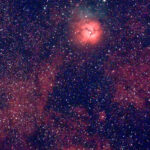 |
M20 / NGC 6514 / Trifid Nebula | M20 was discovered by Messier (eighth so far) and recorded on June 5, 1764: "Cluster of stars, a little above the Ecliptic, between the bow of Sagittarius & the right foot of Ophiuchus..' His description is completed at the end of his entry for M21 (same date) where he comments: "The stars of both these clusters [M20 & M21] are of 8-9 magnitude, enveloped in nebulosity." <--> The Trifid Nebula is a bright spot, low on the Southern Horizon, just above the Lagoon Nebula... It is connected by a band of HII gas to the Lagoon, although it's unclear whether Messier could see this. Collectively, these make up one of the most active star forming regions in our part of the Milky Way, eclipsed only by the Orion complex. Trifid, btw, means "3-lobed" which is an obvious name when you examine the "bulb" and appear to be an illusion established by strands of dark nebulae stretched across the HII bubble. The blueish "cap" is a reflection nebula. I hadn't planned on observing this object, but it was a partly cloudy night and the southern horizon was the clearest. The Trifid was quite low, around 20° when the observation started, but far enough west to miss the tall trees on my property which are closer to the meridian. Transparency was mediocre, with a rising moon illuminating the sky. But I was able to capture this fairly quickly, with my camera set to Bin 2 and using the L-eNhance dual band filter. The bright edge at the bottom of the image is the start of the Lagoon Nebula (M8). |
